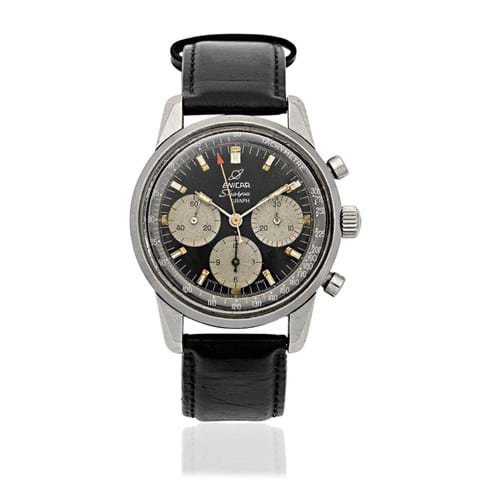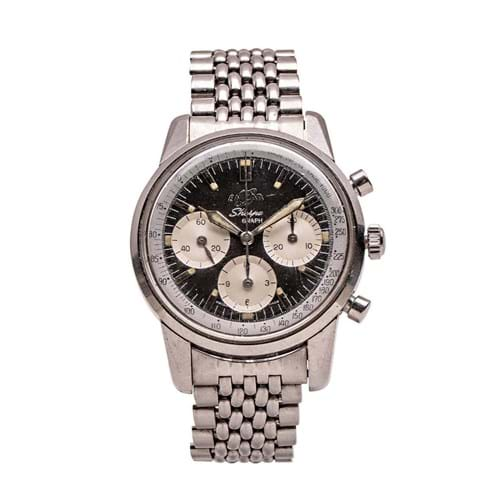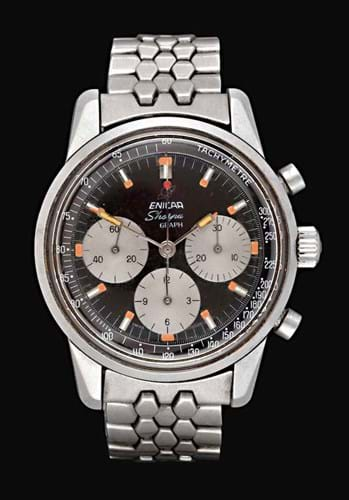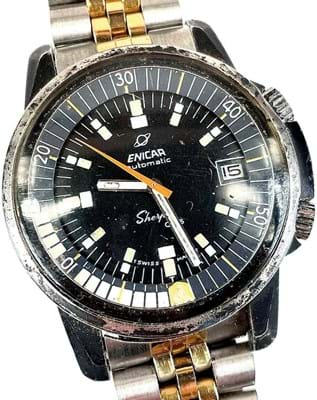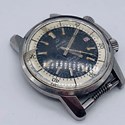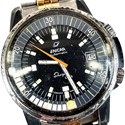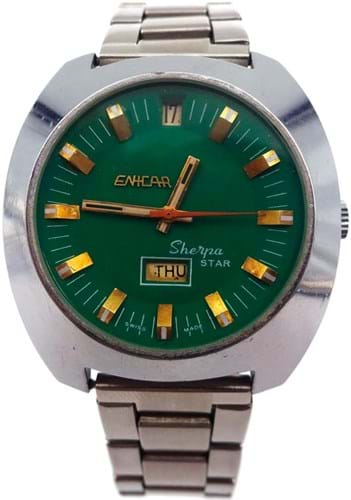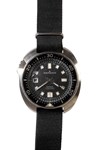In the late 1950s, the Swiss watchmaker Enicar began supplying watches to sportsmen and adventurers as a marketing exercise.
At the time conquering the world’s highest peaks was still big news. After Enicar ‘explorer’ watches kept accurate time during the 1956 Swiss Himalayan expedition to both Mount Everest and Lhotse, the wave of positive publicity gave rise to a rebrand.
It is the Sherpa series of watches that are today most popular with collectors.
More than 100 different versions were made over the following decade and most of them came with the best cases and movements available.
Beneath the Sherpa Graph is the Valjoux 72, the same technology in the back of the Daytona Cosmograph, while the Sherpa Dive line adopted the Compressor case patented by the Swiss case manufacture Ervin Piquerez in the late 1950s. One of these, a Sherpa Ocean Pearl, was strapped to the keel of the sailing ship, Mayflower II, as it crossed the Atlantic between April and June 1957.
Motorsport history
The Sherpa Graph 300 models with black tachymeter ‘reverse panda’ dial and pump-style pushers have a motorsport history. They were promoted by Stirling Moss in 1960 and Jim Clark, who wore one on the way to the Formula One world championship in 1962 and 1963. Across as many as eight variants, there are small changes in dial, logo and hand design that collectors like to highlight.
The Sherpa Graph 300 offered by Canadian firm Miller & Miller (18% buyer’s premium) in New Hamburg, Ontario, on June 11 was a 1960 Enicar Sherpa Graph Mark 1A featuring the rare sword-like ‘gladius’ hands. It was expected to bring Can$7000-10,000 but in the end almost doubled the top estimate when it finished at Can$19,000 (£12,200).
“Ten years ago, you could have acquired this for around $1500”, said auctioneers Justin and Ethan Miller. “One of the factors contributing to this appreciation was the fact that prices for Rolex Daytonas have gone crazy and the Sherpa Graph uses the same movement. Comparatively, it remains a bargain.”
A slightly later variation of the Sherpa Graph 300 (probably a Mark 2A c.1963) with a logo change and ‘paddle’ hands sold for £4200 at Bonhams in February, while Tennants (20% buyer’s premium) sold a Mark 3 watch from c.1966 for £6800 in November 2021. Particular to this model is the second hand with a round lollipop red dot, and the stick pointers to the subs. It came with its original bracelet and papers including a receipt for Sin$127 from a jeweller in Singapore dated August 26, 1967.
At this point in its lifespan, Enicar (the name comes from the backwards spelling of the founding Racine family) was a pioneering firm. It had introduced an electro-mechanical watch in 1961 and, ironically for a firm that went to the wall in the quartz crisis, was engaged in the CEH Beta 21 project in Neuchâtel that made the first Swiss quartz watch. The Sherpa diving watches are also distinctive.
Most diving chronos have a timing bezel that rotates outside the case. Instead, the Enicar’s timing bezel on its Ultradive range rotated internally and was operated through a secondary crown. Not everyone liked it (wearing gloves it was difficult to manipulate the crown) but they were popular. The example offered at auction by Atkins (17% buyer’s premium) in Axminster, Devon, on April 1 made £2900.
The Sherpa OPS differentiates itself from the Ultradive by a PVD coated case and matte black dial with orange and tritium accents. It actually had no direct military associations, but it is pretty clear where the inspiration came from. It is one of several Enicar vintage issues that have recently been reissued.
The original example offered at David Lay (18% buyer’s premium) in Penzance on June 16 was in well-worn condition with losses to the PVD coating and age-faded lume. It made £2000.
In the 1970s, Enicar started to add the word Sherpa to other (lesser) watches in its range watches to stimulate sales. The line was expanded to include the Sherpa Date, the Sherpa GMT, the Sherpa World Time and the Sherpa Star – the latter the firm’s budget range.
These were and remain an affordable option – an example with a green enamel dial with day date aperture sold for £130 at David Duggleby (21% buyer’s premium) in Scarborough on June 9.


